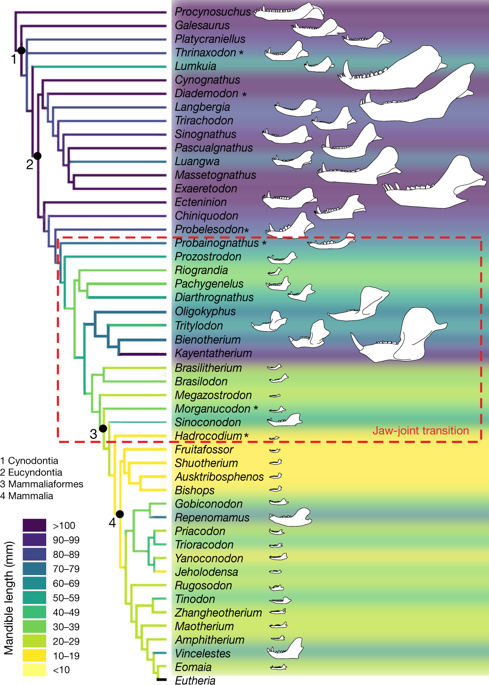Our official English website, www.x-mol.net, welcomes your
feedback! (Note: you will need to create a separate account there.)
The role of miniaturization in the evolution of the mammalian jaw and middle ear
Nature ( IF 50.5 ) Pub Date : 2018-09-01 , DOI: 10.1038/s41586-018-0521-4 Stephan Lautenschlager , Pamela G. Gill , Zhe-Xi Luo , Michael J. Fagan , Emily J. Rayfield
Nature ( IF 50.5 ) Pub Date : 2018-09-01 , DOI: 10.1038/s41586-018-0521-4 Stephan Lautenschlager , Pamela G. Gill , Zhe-Xi Luo , Michael J. Fagan , Emily J. Rayfield

|
The evolution of the mammalian jaw is one of the most important innovations in vertebrate history, and underpins the exceptional radiation and diversification of mammals over the last 220 million years1,2. In particular, the transformation of the mandible into a single tooth-bearing bone and the emergence of a novel jaw joint—while incorporating some of the ancestral jaw bones into the mammalian middle ear—is often cited as a classic example of the repurposing of morphological structures3,4. Although it is remarkably well-documented in the fossil record, the evolution of the mammalian jaw still poses the paradox of how the bones of the ancestral jaw joint could function both as a joint hinge for powerful load-bearing mastication and as a mandibular middle ear that was delicate enough for hearing. Here we use digital reconstructions, computational modelling and biomechanical analyses to demonstrate that the miniaturization of the early mammalian jaw was the primary driver for the transformation of the jaw joint. We show that there is no evidence for a concurrent reduction in jaw-joint stress and increase in bite force in key non-mammaliaform taxa in the cynodont–mammaliaform transition, as previously thought5–8. Although a shift in the recruitment of the jaw musculature occurred during the evolution of modern mammals, the optimization of mandibular function to increase bite force while reducing joint loads did not occur until after the emergence of the neomorphic mammalian jaw joint. This suggests that miniaturization provided a selective regime for the evolution of the mammalian jaw joint, followed by the integration of the postdentary bones into the mammalian middle ear.Biomechanical analyses of mammaliaform and cynodont fossils demonstrate that miniaturization drove the evolutionary transformation of the mammalian jaw, which preceded the optimization of bite force-to-joint load in the mandible
中文翻译:

小型化在哺乳动物颌骨和中耳进化中的作用
哺乳动物颌骨的进化是脊椎动物历史上最重要的创新之一,是过去 2.2 亿年来哺乳动物异常辐射和多样化的基础1,2。尤其是下颌骨转变为单牙骨和新型颌骨关节的出现——同时将一些祖先的颌骨纳入哺乳动物的中耳——经常被引用为形态学再利用的经典例子。结构3,4。尽管它在化石记录中得到了很好的记录,但哺乳动物下颌的进化仍然提出了一个悖论,即祖先下颌关节的骨头如何既可以作为强大的负重咀嚼的关节铰链,也可以作为下颌中耳那是足以听得见的细腻。这里我们使用数字重建,计算模型和生物力学分析证明早期哺乳动物下颌的小型化是下颌关节转变的主要驱动力。我们表明,没有证据表明在犬齿类动物-哺乳动物类过渡中的关键非哺乳动物类群中,颌关节应力同时降低,咬合力增加,正如之前认为的 5-8。尽管在现代哺乳动物的进化过程中下颌肌肉组织的募集发生了变化,但直到新形哺乳动物下颌关节出现之后,才开始优化下颌功能以增加咬合力同时减少关节负荷。这表明小型化为哺乳动物颌关节的进化提供了选择性机制,随后齿后骨整合到哺乳动物中耳中。
更新日期:2018-09-01
中文翻译:

小型化在哺乳动物颌骨和中耳进化中的作用
哺乳动物颌骨的进化是脊椎动物历史上最重要的创新之一,是过去 2.2 亿年来哺乳动物异常辐射和多样化的基础1,2。尤其是下颌骨转变为单牙骨和新型颌骨关节的出现——同时将一些祖先的颌骨纳入哺乳动物的中耳——经常被引用为形态学再利用的经典例子。结构3,4。尽管它在化石记录中得到了很好的记录,但哺乳动物下颌的进化仍然提出了一个悖论,即祖先下颌关节的骨头如何既可以作为强大的负重咀嚼的关节铰链,也可以作为下颌中耳那是足以听得见的细腻。这里我们使用数字重建,计算模型和生物力学分析证明早期哺乳动物下颌的小型化是下颌关节转变的主要驱动力。我们表明,没有证据表明在犬齿类动物-哺乳动物类过渡中的关键非哺乳动物类群中,颌关节应力同时降低,咬合力增加,正如之前认为的 5-8。尽管在现代哺乳动物的进化过程中下颌肌肉组织的募集发生了变化,但直到新形哺乳动物下颌关节出现之后,才开始优化下颌功能以增加咬合力同时减少关节负荷。这表明小型化为哺乳动物颌关节的进化提供了选择性机制,随后齿后骨整合到哺乳动物中耳中。











































 京公网安备 11010802027423号
京公网安备 11010802027423号